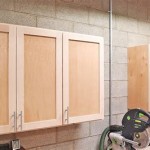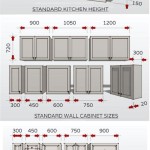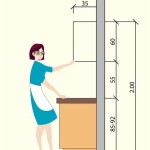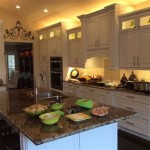Renewing Wood Kitchen Cabinets: A Comprehensive Guide
Wood kitchen cabinets, prized for their warmth, durability, and aesthetic appeal, often form the centerpiece of a kitchen design. However, over time, these cabinets can become worn, faded, or simply outdated. Instead of undertaking a costly and disruptive remodel, homeowners can renew their existing wood cabinets, revitalizing the heart of their home with a relatively simple and cost-effective approach. This article provides a comprehensive guide to renewing wood kitchen cabinets, covering the necessary preparations, various renewal methods, and essential maintenance tips.
Before embarking on any renewal project, a thorough assessment of the existing cabinets is crucial. This involves identifying the type of wood, the existing finish, and the extent of any damage. Knowing whether the cabinets are solid wood or veneered wood will influence the choice of cleaning agents, sanding techniques, and refinishing products. Visible damage, such as scratches, dents, water stains, or warped sections, must be documented and addressed appropriately. This upfront analysis ensures that the chosen renewal method aligns with the specific needs and challenges presented by the cabinets, maximizing the likelihood of a satisfactory outcome.
Preparing the Cabinets for Renewal
Proper preparation is paramount to achieving a professional-looking finish. This stage involves several key steps, including removing hardware, cleaning the surfaces, and sanding the wood. Failure to adequately prepare the cabinets can result in an uneven finish, poor adhesion of the new coating, and ultimately, a less-than-desirable result.
The first step is to remove all hardware, including knobs, pulls, hinges, and any other attached elements. This not only protects these components from damage during the cleaning and sanding processes but also allows for thorough cleaning and refinishing of the cabinet surfaces. Labeling the hardware and their corresponding cabinet doors and drawers is essential for easy reinstallation later. Store the hardware in a safe place to prevent loss or damage.
Next, the cabinets need to be thoroughly cleaned to remove grease, grime, and any existing dirt or dust. A degreasing cleaner specifically designed for wood is highly recommended. Avoid harsh chemicals or abrasive cleaners, as these can damage the wood finish. Apply the cleaner according to the manufacturer's instructions, paying close attention to crevices and areas prone to grease buildup, such as around the stovetop. Rinse the surfaces with clean water and allow them to dry completely before proceeding to the next step. Stubborn stains may require additional cleaning with specialized products designed for removing specific types of stains.
Sanding is a crucial step in preparing the cabinets for refinishing. The purpose of sanding is to create a smooth, even surface that will allow the new finish to adhere properly. The specific sanding technique and grit of sandpaper will depend on the existing finish and the desired outcome. For cabinets with a glossy finish, a coarser grit sandpaper (e.g., 120-grit) may be needed to remove the existing coating. For cabinets with a lighter finish or minor imperfections, a finer grit sandpaper (e.g., 220-grit) may suffice. Sand in the direction of the wood grain, using a sanding block or orbital sander for larger surfaces. Avoid applying excessive pressure, as this can create unevenness or damage the wood. After sanding, remove all sanding dust with a tack cloth or vacuum cleaner.
Methods for Renewing Wood Kitchen Cabinets
Several methods can be employed to renew wood kitchen cabinets, each offering varying degrees of transformation and complexity. The choice of method will depend on the homeowner's budget, skill level, and desired aesthetic outcome. Common methods include cleaning and polishing, refinishing, painting, and refacing.
Cleaning and Polishing: This is the simplest and least invasive method, suitable for cabinets that are in relatively good condition and only require a refresh. A specialized wood cleaner and polish can remove surface dirt, grease, and minor imperfections, restoring the shine and luster of the existing finish. This method is best suited for cabinets with minimal wear and tear and a well-maintained finish. Apply the cleaner and polish according to the manufacturer's instructions, using a soft cloth to buff the surfaces to a shine. This method can be a quick and easy way to enhance the appearance of wood cabinets without requiring extensive labor or specialized tools.
Refinishing: Refinishing involves stripping the existing finish from the cabinets and applying a new coating of stain or varnish. This method allows for a more significant transformation, allowing the homeowner to change the color or sheen of the cabinets. Refinishing is a more labor-intensive process than cleaning and polishing, requiring careful preparation and application techniques. The first step is to strip the existing finish using a chemical stripper or sanding. Chemical strippers can be effective but require careful handling and ventilation. Sanding is a more manual process but allows for greater control over the removal of the finish. Once the existing finish has been removed, the cabinets can be stained or varnished. Choose a stain or varnish that is compatible with the type of wood and desired aesthetic. Apply the finish in thin, even coats, allowing each coat to dry completely before applying the next. Sand lightly between coats to ensure a smooth, even finish.
Painting: Painting wood kitchen cabinets is a popular option for those seeking a dramatic change in color or style. Painting can completely transform the look of the kitchen, offering a wide range of color choices and finishes. However, it is important to properly prepare the cabinets before painting to ensure a durable and long-lasting finish. After cleaning and light sanding, apply a primer specifically designed for wood. Primer helps to seal the wood and provide a smooth surface for the paint to adhere to. Choose a high-quality paint that is specifically formulated for kitchen cabinets. Apply the paint in thin, even coats, using a brush, roller, or sprayer. Allow each coat to dry completely before applying the next. Sand lightly between coats to remove any imperfections and create a smooth finish. Consider applying a clear topcoat to protect the paint and enhance its durability. This is especially important for high-traffic areas, such as around the sink and stovetop.
Refacing: Refacing involves replacing the cabinet doors and drawer fronts while leaving the existing cabinet boxes in place. This method is a cost-effective alternative to replacing the entire cabinet system, allowing for a significant change in appearance without the need for extensive demolition and reconstruction. Refacing can be a good option for homeowners who are happy with the layout of their kitchen but want to update the style of their cabinets. Choose new doors and drawer fronts that are compatible with the existing cabinet boxes. Measure the existing doors and drawer fronts carefully to ensure a proper fit. Install the new doors and drawer fronts using the existing hinges and hardware, or replace them with new ones if desired. Refacing can be a less disruptive and less expensive alternative to replacing the entire cabinet system, providing a fresh new look for the kitchen.
Maintaining Renewed Wood Kitchen Cabinets
Once the wood kitchen cabinets have been renewed, proper maintenance is essential to preserving their appearance and longevity. Regular cleaning, appropriate product usage, and prompt attention to any damage can help to keep the cabinets looking their best for many years to come.
Regular cleaning is crucial for preventing the buildup of grease, grime, and dirt. Wipe down the cabinets with a damp cloth and a mild detergent solution on a regular basis, paying particular attention to areas around the stovetop and sink. Avoid using harsh chemicals or abrasive cleaners, as these can damage the finish. Dry the cabinets thoroughly after cleaning to prevent water spots and potential water damage. For stubborn stains, use a specialized wood cleaner designed for removing specific types of stains.
Use appropriate cleaning products specifically designed for wood surfaces. Avoid using harsh chemicals, abrasive cleaners, or excessive amounts of water. When cleaning, use a soft cloth or sponge to avoid scratching the finish. Consider using a wood polish or conditioner periodically to help maintain the moisture content of the wood and prevent it from drying out and cracking. Follow the manufacturer's instructions for applying the polish or conditioner, and avoid over-application.
Address any damage promptly to prevent it from worsening. Scratches, dents, or water stains should be repaired as soon as possible. Small scratches can often be repaired with a touch-up marker or furniture polish. Deeper dents may require filling with wood putty and sanding before refinishing. Water stains should be dried thoroughly and treated with a specialized wood stain remover. Addressing damage promptly can help to prevent it from spreading and requiring more extensive repairs in the future.
Controlling humidity levels in the kitchen can also help to protect the wood cabinets. Excessive humidity can cause the wood to warp or swell, while low humidity can cause it to dry out and crack. Use a dehumidifier or humidifier as needed to maintain a consistent humidity level in the kitchen. Ensure proper ventilation in the kitchen by using the range hood when cooking and opening windows periodically. This can help to prevent the buildup of moisture and condensation, which can damage the wood cabinets.
By following these maintenance tips, homeowners can help to ensure that their renewed wood kitchen cabinets remain beautiful and functional for many years to come. Consistent care and attention will protect the investment made in renewing the cabinets and preserve the value and appeal of the kitchen.

How To Re Wood Cabinets Trends Finishing

How To Refinish Kitchen Cabinets Diy

Refinishing Kitchen Cabinets Modern Refacing Made Easy Wisewood

How To Refinish Kitchen Cabinets N Hance

The Fast Affordable Way To Upgrade Your Kitchen Cabinet Refinishing

Should I Paint Or Refinish My Kitchen Cabinets

How To Re Worn Kitchen Cabinets Without A Complete Overhaul The Seattle Times

How To Re Cabinets Bob Vila S Blogs
Refinishing Kitchen Cabinets A Beautiful Mess

Refinishing Kitchen Cabinets Modern Refacing Made Easy Wisewood
Related Posts








